David Petersen's Blog, page 7
August 20, 2024
Magic The Gathering: Helga, Skittish Seer
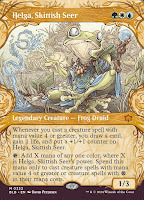 Last year I was asked by Wizards of the Coast to do some Magic the Gathering card art for their upcoming animal set Bloomburrow (https://magic.wizards.com/en/products/bloomburrow). I played a lot of MtG back in the mid/late 90's, so it was an honor and thrill to become a part of the fraternity of MtG illustrators.
Last year I was asked by Wizards of the Coast to do some Magic the Gathering card art for their upcoming animal set Bloomburrow (https://magic.wizards.com/en/products/bloomburrow). I played a lot of MtG back in the mid/late 90's, so it was an honor and thrill to become a part of the fraternity of MtG illustrators.Here is Helga, Skittish Seer, one of the Frogfolk, who despite bing my 3rd card revealed, was my first to draw. The set was released in early August, and since Wizards of the Coast has already revealed my version of this card, I can share the artwork and process for creating it.
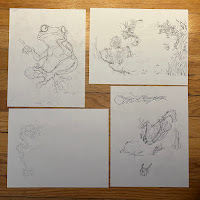 The process started with the brief from my art director Aliana Rood
The process started with the brief from my art director Aliana Roodasking for Helga, a Lemur Tree Frog sitting on the banks of a pond staring into the distance while absentmindedly conjuring water magic. They wanted a tone of adolescent angst and loneliness. WotC provided me with an enormous PDF with reference for the frogs and their clothing as well as reference for Helga's specific character design.
I started with a pencil version of Helga on copy paper to get the pose and mood of the character right. I then placed another sheet of copt paper over her on a lightpad and drew her costuming. The brief also called for a specific blend of frogfolk and ratfolk architecture in the background, so that was done on another sheet as well which is why there is a void on the background pencils. Lastly I penciled a version of her twisty water magic.
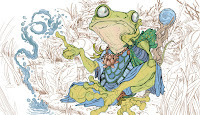 All of those pencil roughs were assembled and combined digitally in Photoshop as well as tweaked with reproportioning and rotating elements. At this stage, I also like to do a preliminary digital color blocking, to make sure I have the color and value tangents worked out, and also to show my art director at WotC so they are on the same page as I am (no one likes surprises in the later stages of a commissioned art piece).
All of those pencil roughs were assembled and combined digitally in Photoshop as well as tweaked with reproportioning and rotating elements. At this stage, I also like to do a preliminary digital color blocking, to make sure I have the color and value tangents worked out, and also to show my art director at WotC so they are on the same page as I am (no one likes surprises in the later stages of a commissioned art piece).  With the pencils/layouts approved by my art director, I moved on to inks. I printed the digital composite out and taped it to the back of a sheet of Strathmore 300 series bristol. On my Huion Lightpad, I was able to see through the surface of the bristol to use the printout as a guide as I inked with Copic Multiliner SP pens. The art director for this card requested not to have any large or dense areas of black, so I kept the linework fairly open and was restrained with the amount of texture.
With the pencils/layouts approved by my art director, I moved on to inks. I printed the digital composite out and taped it to the back of a sheet of Strathmore 300 series bristol. On my Huion Lightpad, I was able to see through the surface of the bristol to use the printout as a guide as I inked with Copic Multiliner SP pens. The art director for this card requested not to have any large or dense areas of black, so I kept the linework fairly open and was restrained with the amount of texture.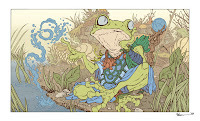 The inks were then scanned back into Photoshop where I could start the coloring process. This stage. called flatting' is the professional version of coloring-in-the-lines. Just flat color is placed in to establish everything's base colors. the art director also liked when my linework was softer in my Mouse Guard work, and wanted everything to have a dark brown color hold (ink lines colored to be something other than black). I also established other color holds on Helga's eyes, the water bits, and the entire background.
The inks were then scanned back into Photoshop where I could start the coloring process. This stage. called flatting' is the professional version of coloring-in-the-lines. Just flat color is placed in to establish everything's base colors. the art director also liked when my linework was softer in my Mouse Guard work, and wanted everything to have a dark brown color hold (ink lines colored to be something other than black). I also established other color holds on Helga's eyes, the water bits, and the entire background. 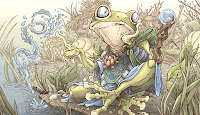 Here are the final rendered colors for the art (sans card borders). I did the light and shadow and texture by using the dodge and burn tools in Photoshop with a stock textured brush.
Here are the final rendered colors for the art (sans card borders). I did the light and shadow and texture by using the dodge and burn tools in Photoshop with a stock textured brush.I have prints and playmats of Helga available for sale: https://mouseguard.bigcartel.com/category/magic.
August 13, 2024
Bloomburrow Tee
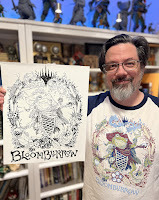 Wizards of the Coast asked me to do artwork for a tee-shirt that the Bloomburrow team would have for the release, when demoing the game, and as a memento of the new card set from Magic the Gathering.
Wizards of the Coast asked me to do artwork for a tee-shirt that the Bloomburrow team would have for the release, when demoing the game, and as a memento of the new card set from Magic the Gathering.I was given a lot of free reign and asked to draw an adventurer from Bloomburrow in my own style that summed up the cozy but serious vibes the setting provided. They also asked me to hand letter a version of the logo, but allowed me to take liberties with it. Of course, because it was a silk-screened shirt, there were color limitations.
To the left you can see the baseball version of the tee WotC sent me, but below I'll go through the steps for creating the art.
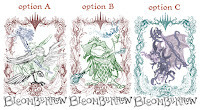 I was given options for the species of the focus of the tee: Bird, Bat, or Frog (though I think they were open to me trying another animal if I felt strongly about it). The art brief asked for the Planeswalker logo and for the design to be self contained, so I decided I'd draw a border of natural plant elements with the symbol at the top (I also liked the idea of a circle of the mana symbols at the bottom to balance it out. I sent over a bird, frog, and bat rough options, each with their own border plant details to echo some of those species mana colors.
I was given options for the species of the focus of the tee: Bird, Bat, or Frog (though I think they were open to me trying another animal if I felt strongly about it). The art brief asked for the Planeswalker logo and for the design to be self contained, so I decided I'd draw a border of natural plant elements with the symbol at the top (I also liked the idea of a circle of the mana symbols at the bottom to balance it out. I sent over a bird, frog, and bat rough options, each with their own border plant details to echo some of those species mana colors.
The Art Director liked the frog version best, but asked for a few changes: to make the water magic more swirly, to make it overall oval shaped, and to add bugs to the border. I tightened up the pencil drawings of the frogfolk and the new round border as well as adding in some ladybugs (which I thought had a nice easy to see pattern that wouldn't get lost in the detail of the border line chaos).
These pencil drawings were all assembled in Photoshop and tinted to ultimately help me see everything clearer when I'd get to the next step.
 Before I could start inking, there was one more request to change out a few of the ladybugs for other insects, so one became a grasshopper and the other a moth.
Before I could start inking, there was one more request to change out a few of the ladybugs for other insects, so one became a grasshopper and the other a moth. I printed this big piece out and taped it to the back of a 14" x 17" sheet of Strathmore 300 series bristol. On my Huion lightpad, I could see through the surface of the bristol to the pencils underneath and use them as a guide. I used Copic Multiliner SP pens (I think just the 0.7 nib)
I scanned the inks so I could start on breaking down the colors for a limited color silk-screened shirt.
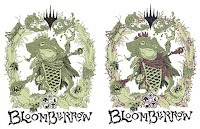 I first tried with a three color and a four color pass (each color on its own layer to make it easier for the silkscrener).
I first tried with a three color and a four color pass (each color on its own layer to make it easier for the silkscrener).Happier with the four color version I turned it in to the Art Director––but he surprised me by suggesting to add some more colors to make the water magic pop in the final.
Here is the finished art I sent off to WotC for the shirt. They ended up swapping out my hand-drawn Bloomburrow logo for the official one (never heard why). Someday for fun I'll see what it would look like if I did a full color render of this art.

August 6, 2024
Infant Melon Dragon
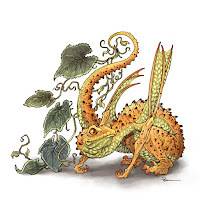 Last week on my Twitch Stream, we did the #DiscoveringDragons Community-Draw-Along! It's a fun event where I welcome all skill levels to push their pencils (or whatever tools they use to make art). It takes place on the first Friday of the month.I worked on my piece live on my Twitch stream while viewers worked at home and then on the following Monday we shared our finished pieces.
Last week on my Twitch Stream, we did the #DiscoveringDragons Community-Draw-Along! It's a fun event where I welcome all skill levels to push their pencils (or whatever tools they use to make art). It takes place on the first Friday of the month.I worked on my piece live on my Twitch stream while viewers worked at home and then on the following Monday we shared our finished pieces.Here is my finished colored Dragon (twentieth in the series). And below are my steps to create it as well as the community submissions.
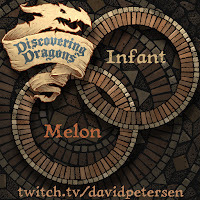 For #DiscoveringDragons, I post two or three prompt words for everyone to make into a dragon. It's a nice framework for artists of any skill level to focus some time on an 'assignment' to shake the rust off or get the pencil moving again––all while also being loose enough that there's plenty of room for individual expression and interpretation.
For #DiscoveringDragons, I post two or three prompt words for everyone to make into a dragon. It's a nice framework for artists of any skill level to focus some time on an 'assignment' to shake the rust off or get the pencil moving again––all while also being loose enough that there's plenty of room for individual expression and interpretation.This month the prompt was two words: Infant & Melon
I opened several tabs of google image searches of baby dragons, watermelons, & cantaloupes.
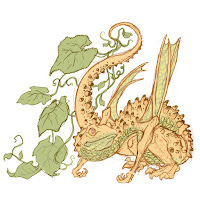 I started on copy paper with the body form of my baby dragon. I thought of going with more of a cute swaddled infant of a chibi character, and opted for this young looking dragon shape. I'd originally planned to use a watermelon as my melon reference––but Julia suggested I look up a 'horned melon'.
I started on copy paper with the body form of my baby dragon. I thought of going with more of a cute swaddled infant of a chibi character, and opted for this young looking dragon shape. I'd originally planned to use a watermelon as my melon reference––but Julia suggested I look up a 'horned melon'.Using my lightpad, over the top of my pencils for the dragon shape, I drew new details of the horned melon and the inner fruit-seeds for the belly and tail vines/leaves. All of these pencils were scanned into Photoshop and assembled with some quick color blocking to get my layout where I wanted it.
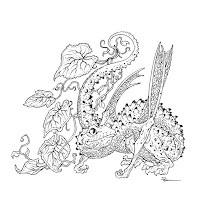
I printed out the above design at full scale and taped that onto the back of a sheet of Strathmore 300 series bristol. Using a lightpad, I was able to see through the surface of the bristol as I inked the dragon. I used Copic Multiliner 0.7 pen to ink the art.
The inking on this piece was a subtle affair of getting the horned melon rind texture right, and then using lighter weight lines for the seeds (imbedded in the fruit) and a slightly different texture of the leaves.
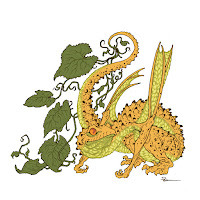 I was able to finish my inks on stream and even started the coloring process before having to sign off an wish every one success over the weekend with their Dragons. Later that same night after some dinner I finished the flatting process. In addition to the basics of color flatting–basically professional coloring-in-the-lines, I also established color holds (an area where I want the ink to be a color other than black)––the overall lines became a dark brown the belly became a medium green, the seeds a light green, the pupils red, and the leave veins dark green.
I was able to finish my inks on stream and even started the coloring process before having to sign off an wish every one success over the weekend with their Dragons. Later that same night after some dinner I finished the flatting process. In addition to the basics of color flatting–basically professional coloring-in-the-lines, I also established color holds (an area where I want the ink to be a color other than black)––the overall lines became a dark brown the belly became a medium green, the seeds a light green, the pupils red, and the leave veins dark green.Most of of the color selections were already established in the rough, but I played with the final value/hue choices for a while before getting to this point.
For the final colors I used a bit of the paintbrush to make the tip of each 'horn' of the melon skin a darker orange, and then the dodge and burn tools to add shadows and highlights to give the dragons some form.
Below you can again see the final Dragon...
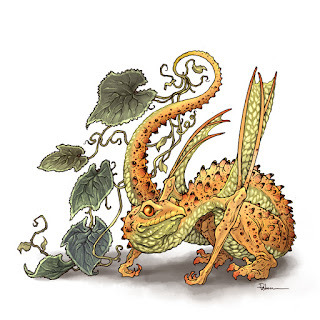
But, as this is a community event, I wanted to share all the other entries posted in the Discord.
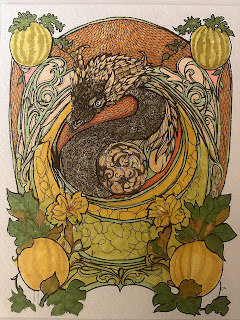 Capt.Nemo
Capt.Nemo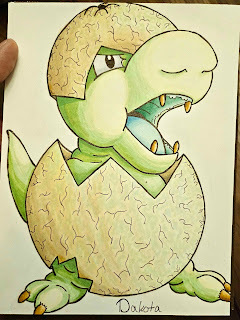
Dakota
 JC
JC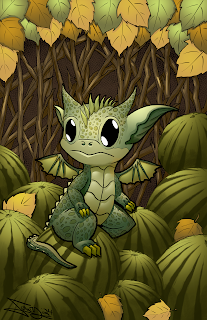
Jonathan Towry
 KyleGerbrandt
KyleGerbrandt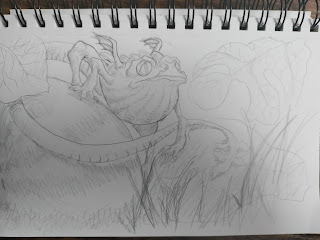 Maliloki
Maliloki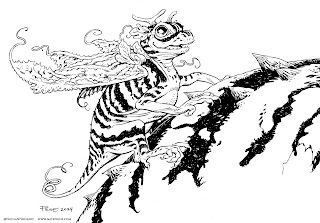 Nathan Pride
Nathan Pride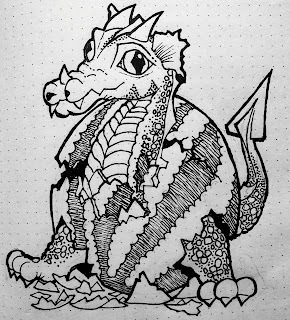 Pendrake
Pendrake redSkwrl
redSkwrl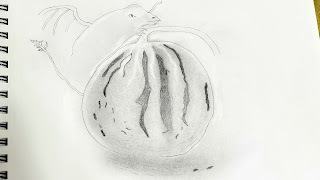 SoulSeekerOlga
SoulSeekerOlga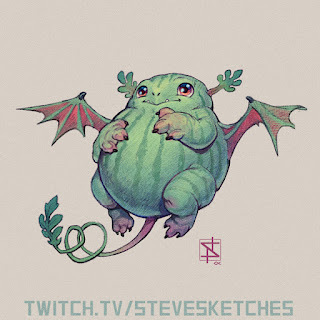 SteveSketches
SteveSketches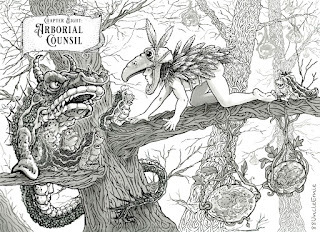 88UncleErnie
88UncleErnie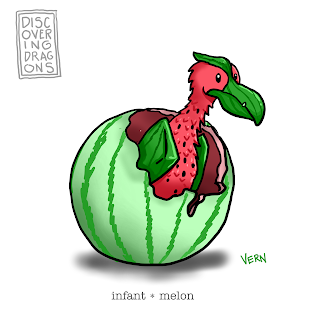 VernNYC
VernNYCJuly 30, 2024
Magic The Gathering: Kitsa
 Last year I was asked by Wizards of the Coast to do some Magic the Gathering card art for their upcoming animal set Bloomburrow (https://magic.wizards.com/en/products/bloomburrow). I played a lot of MtG back in the mid/late 90's, so it was an honor and thrill to become a part of the fraternity of MtG illustrators.
Last year I was asked by Wizards of the Coast to do some Magic the Gathering card art for their upcoming animal set Bloomburrow (https://magic.wizards.com/en/products/bloomburrow). I played a lot of MtG back in the mid/late 90's, so it was an honor and thrill to become a part of the fraternity of MtG illustrators.Here is Kitsa, Otterball Elite. Wizards of the Coast has already revealed my version of this card so, I can share the artwork and process for creating it.

The process started with the brief from my art director asking for Kitsa, an otter athlete, slapping an energy ball with his tail through netted hoops while casting a spell. WotC provided me with an enormous PDF with reference for the otters and their clothing and culture for Bloomburrow.
I started with a rough version of Kitsa on copy paper––which was pretty much just studying real-world photos of otters. I then refined the drawing on a different sheet of copy paper using a lightpad to work off of the original. The armor/costuming was so detailed, that once I had my tight drawing of Kitsa, I could overlay another sheet of copy paper on the light pad and draw it all without worrying about erasing a part and ruining the original otter drawing.
The Art Director asked for a change with Kitsa's paw that happened later in the process, but I wanted to address it here since every image after this will have that revision.
 The pencil roughs were assembled and combined digitally in Photoshop. Since the background was all underwater, I figured it would be easier to add in those rough shapes digitally with paint brushes and marquee tools. For the bubble placement, I had a layer with a thin outline applied to wherever I pained, so I could add in those light bubble shapes and get something with a defined edge to ink from later. I also gave myself some notes about the magic effects.
The pencil roughs were assembled and combined digitally in Photoshop. Since the background was all underwater, I figured it would be easier to add in those rough shapes digitally with paint brushes and marquee tools. For the bubble placement, I had a layer with a thin outline applied to wherever I pained, so I could add in those light bubble shapes and get something with a defined edge to ink from later. I also gave myself some notes about the magic effects.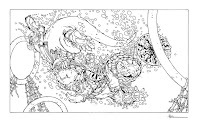 With the pencils/layouts approved by my art director, I moved on to inks. I printed the digital composite out and taped it to the back of a sheet of Strathmore 300 series bristol. On my Huion Lightpad, I was able to see through the surface of the bristol to use the printout as a guide as I inked with Copic Multiliner SP pens. The art director for this card requested not to have any large or dense areas of black, so I kept the linework fairly open and was restrained with the amount of texture. The magic around the eyes and coming off of his hand and the ball were inked separately on a sheet of copy paper (not seen here).
With the pencils/layouts approved by my art director, I moved on to inks. I printed the digital composite out and taped it to the back of a sheet of Strathmore 300 series bristol. On my Huion Lightpad, I was able to see through the surface of the bristol to use the printout as a guide as I inked with Copic Multiliner SP pens. The art director for this card requested not to have any large or dense areas of black, so I kept the linework fairly open and was restrained with the amount of texture. The magic around the eyes and coming off of his hand and the ball were inked separately on a sheet of copy paper (not seen here).
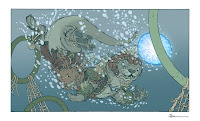 The inks were then scanned back into Photoshop where I could start the coloring process. This stage. called flatting' is the professional version of coloring-in-the-lines. Just flat color is placed in to establish everything's base colors. the art director also liked when my linework was softer in my Mouse Guard work, and wanted everything to have a dark blue-green color hold (ink lines colored to be something other than black). I also established other color holds on the bubbles, the costume details, and the energy ball.
The inks were then scanned back into Photoshop where I could start the coloring process. This stage. called flatting' is the professional version of coloring-in-the-lines. Just flat color is placed in to establish everything's base colors. the art director also liked when my linework was softer in my Mouse Guard work, and wanted everything to have a dark blue-green color hold (ink lines colored to be something other than black). I also established other color holds on the bubbles, the costume details, and the energy ball.
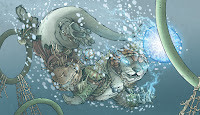
Here are the final rendered colors for the art (sans card borders) with the magic effects added in. I did the light and shadow and texture by using the dodge and burn tools in Photoshop with a stock textured brush.
After Bloomburrow is released in August, I'll have prints of Kitsa available for sale.
July 23, 2024
Saxon, Kenzie, and Rand
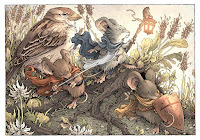 Saxon, Kenzie, and Rand––all were rather grand...
Saxon, Kenzie, and Rand––all were rather grand...For SDCC this week, I decided to do a new print. It was a last minute decision, and a crazy rush to get the art finished off to the printer, proofed, and ready with copies for the con. But, I managed to pull it off.
To the left you can see the finished 14" x 20" print. And below, I'll go through the steps to create it.
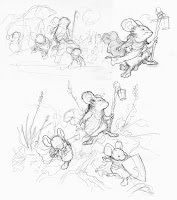 When I started I knew I wanted the print to be large, have known Mouse Guard characters, perhaps a bird, and be as much a landscape study as a Mouse Guard piece. There were a few rough sketches––one very loose, then a tighter one, and a re-draw of Kenzie to get the pose better.
When I started I knew I wanted the print to be large, have known Mouse Guard characters, perhaps a bird, and be as much a landscape study as a Mouse Guard piece. There were a few rough sketches––one very loose, then a tighter one, and a re-draw of Kenzie to get the pose better.Kenzie standing surveying what's ahead with his lantern staff was clear in my mind as a focal element, but deciding on how many mice, toying with the idea of a mouse structure (or a mouse structure in ruin), and how much/what vegetation was still being discovered in this sketching stage.
 So, I went for a walk...
So, I went for a walk...Around my neighborhood I crouched down and took low-perspective photos of various weeks, exposed tree roots, leaves, and weeds. To the left you can see most of the photos I took on that walk, but there were more with other plants I decided not to use for the final art.
A walk like this can be good. It wasn't long, just 20 min or so––long enough to get away from the desk, think about the piece in a more relaxed environment, and gather some reference.
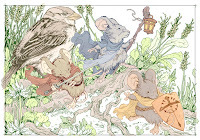 I put it all together with tighter pencil drawings of Saxon, Kenzie, and Rand as well as a sparrow (referenced from a few photos) and a background incorporating the photo inspirations.
I put it all together with tighter pencil drawings of Saxon, Kenzie, and Rand as well as a sparrow (referenced from a few photos) and a background incorporating the photo inspirations. All of these elements were drawn separately on copy paper and then tinted differently in Photoshop as I placed and moved and nudged each character until the layout was right. Then I blocked in some rough color to help me see the forms––what was cloak or leaf or root or feather, etc.
 With the layout locked in, I printed out a version of it that was 20" wide and 14" tall (I did this on three sheets of legal paper and then registered the image and taped them all together.). On my Huion lightpad I inked this huge piece on a trimmed down piece of 24" x 18" bristol with the printout taped to the back. To ink I used a Copic Multiliner SP 0.7 nib pen.
With the layout locked in, I printed out a version of it that was 20" wide and 14" tall (I did this on three sheets of legal paper and then registered the image and taped them all together.). On my Huion lightpad I inked this huge piece on a trimmed down piece of 24" x 18" bristol with the printout taped to the back. To ink I used a Copic Multiliner SP 0.7 nib pen. I'll have the original art for sale at SDCC.
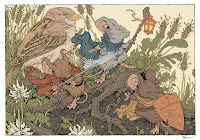 This piece needed to get to the printer though, so as soon as the inks were done, I scanned the art and started coloring by flatting in color. This step is where I block in shapes with flat color (no rendering, so effects) to distinguish all the different color areas––like a coloring-in-the-lines assignment for professionals.
This piece needed to get to the printer though, so as soon as the inks were done, I scanned the art and started coloring by flatting in color. This step is where I block in shapes with flat color (no rendering, so effects) to distinguish all the different color areas––like a coloring-in-the-lines assignment for professionals.At this stage I also added color holds (areas where I want the lineart to be a color other than black) on Rand's shield, Kenzie's lantern, and all of the background (including the sparrow) that is behind the mice.
The last step was a long night or rendering mainly using the dodge and burn tools with a textured brush to give all the forms light and shadow. I'll have 14" x 20" prints available at SDCC and perhaps in my online store after I'm home from the con.
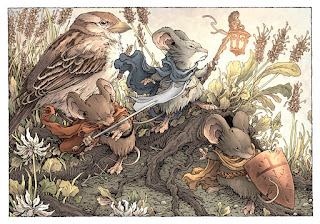
July 16, 2024
Magic The Gathering: Camellia, the Seedmiser
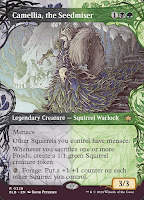 Last year I was asked by Wizards of the Coast to do some Magic the Gathering card art for their upcoming animal set Bloomburrow (https://magic.wizards.com/en/products/bloomburrow). I played a lot of MtG back in the mid/late 90's, so it was an honor and thrill to become a part of the fraternity of MtG illustrators.
Last year I was asked by Wizards of the Coast to do some Magic the Gathering card art for their upcoming animal set Bloomburrow (https://magic.wizards.com/en/products/bloomburrow). I played a lot of MtG back in the mid/late 90's, so it was an honor and thrill to become a part of the fraternity of MtG illustrators.Here is Camellia, the Seedmiser. Squirrels are green/black mana cards with a penchant for bones. The set is in previews now and will be released August 2nd, and since Wizards of the Coast has already revealed my version of this card, I can share the artwork and process for creating it.
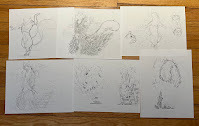 It began with a brief from my art director asking for Camellia descending stairs as a haughty diva showing off her leaf dress.
It began with a brief from my art director asking for Camellia descending stairs as a haughty diva showing off her leaf dress. I started with just squirrel anatomy poses at first until I had one I thought might be a good pose that conveyed 'diva'. On my lightpad though I made several redraws and iterations adding different costuming, trying a few hand poses, and because Julia suggested it––her tail draped over her arm like a stole. The branch and skull setting was suggested from the source material reference as well as the brief. I looked at some real animal skulls for reference.
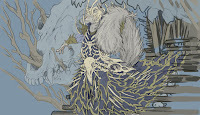 The pencil roughs were assembled and combined digitally in Photoshop. At this stage, I also like to do a preliminary digital color blocking, to make sure I have the color and value tangents worked out, and also to show my art director at WotC so they are on the same page as I am (no one likes surprises in the later stages of a commissioned art piece). This is the stage where I can also easily make adjustments moving a character or resizing something.
The pencil roughs were assembled and combined digitally in Photoshop. At this stage, I also like to do a preliminary digital color blocking, to make sure I have the color and value tangents worked out, and also to show my art director at WotC so they are on the same page as I am (no one likes surprises in the later stages of a commissioned art piece). This is the stage where I can also easily make adjustments moving a character or resizing something. With the pencils/layouts approved by my art director, I moved on to inks. I printed the digital composite out and taped it to the back of a sheet of Strathmore 300 series bristol. On my Huion Lightpad, I was able to see through the surface of the bristol to use the printout as a guide as I inked with Copic Multiliner SP pens. The art director for this card requested not to have any large or dense areas of black, so I kept the linework fairly open and was restrained with the amount of texture.
With the pencils/layouts approved by my art director, I moved on to inks. I printed the digital composite out and taped it to the back of a sheet of Strathmore 300 series bristol. On my Huion Lightpad, I was able to see through the surface of the bristol to use the printout as a guide as I inked with Copic Multiliner SP pens. The art director for this card requested not to have any large or dense areas of black, so I kept the linework fairly open and was restrained with the amount of texture. The inks were then scanned back into Photoshop where I could start the coloring process. This stage. called flatting' is the professional version of coloring-in-the-lines. Just flat color is placed in to establish everything's base colors. the art director also liked when my linework was softer in my Mouse Guard work, and wanted everything to have a dark brown color hold (ink lines colored to be something other than black). I also established other color holds on all the dress trim and details as well as the background to add depth.
The inks were then scanned back into Photoshop where I could start the coloring process. This stage. called flatting' is the professional version of coloring-in-the-lines. Just flat color is placed in to establish everything's base colors. the art director also liked when my linework was softer in my Mouse Guard work, and wanted everything to have a dark brown color hold (ink lines colored to be something other than black). I also established other color holds on all the dress trim and details as well as the background to add depth.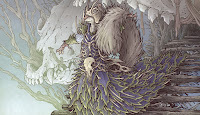 Here are the final rendered colors for the art (sans card borders). I did the light and shadow and texture by using the dodge and burn tools in Photoshop with a stock textured brush. There was a last minute edit at the request of the art director to add more green, so I intensified the glow coming from the left to be unnatural light.
Here are the final rendered colors for the art (sans card borders). I did the light and shadow and texture by using the dodge and burn tools in Photoshop with a stock textured brush. There was a last minute edit at the request of the art director to add more green, so I intensified the glow coming from the left to be unnatural light.When Bloomburrow is released in August, I'll have prints and possibly playmats of Camellia available for sale.
The original inked artwork is up for sale by auction the the Facebook group: MtG Art Market: https://www.facebook.com/groups/mtgartmarket
July 9, 2024
Twin Many-Winged Hare Dragons
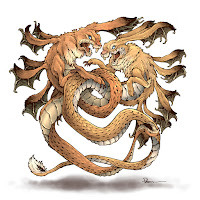 Last week on my Twitch Stream, we did the #DiscoveringDragons Community-Draw-Along! It's a fun event where I welcome all skill levels to push their pencils (or whatever tools they use to make art). It takes place on the first Friday of the month.I worked on my piece live on my Twitch stream while viewers worked at home and then on the following Monday we shared our finished pieces.
Last week on my Twitch Stream, we did the #DiscoveringDragons Community-Draw-Along! It's a fun event where I welcome all skill levels to push their pencils (or whatever tools they use to make art). It takes place on the first Friday of the month.I worked on my piece live on my Twitch stream while viewers worked at home and then on the following Monday we shared our finished pieces.Here is my finished colored Dragon. And below are my steps to create it as well as the community submissions.
 For #DiscoveringDragons, I post two or three prompt words for everyone to make into a dragon. It's a nice framework for artists of any skill level to focus some time on an 'assignment' to shake the rust off or get the pencil moving again––all while also being loose enough that there's plenty of room for individual expression and interpretation.
For #DiscoveringDragons, I post two or three prompt words for everyone to make into a dragon. It's a nice framework for artists of any skill level to focus some time on an 'assignment' to shake the rust off or get the pencil moving again––all while also being loose enough that there's plenty of room for individual expression and interpretation.This month the prompt was three words: Many-Winged, Twin, & Hare
I opened several tabs of google image searches of hares boxing each other, twin dragon coils, and various wing shapes.
 I started on copy paper with the head of the right hare and then worried about how the two would twist and mirror knot together, so I scanned it into Photoshop and started digitally blocking out a body form and mirroring and moving the other layer until I got a placement that worked.
I started on copy paper with the head of the right hare and then worried about how the two would twist and mirror knot together, so I scanned it into Photoshop and started digitally blocking out a body form and mirroring and moving the other layer until I got a placement that worked. I printed that version out and on a lightpad and a fresh sheet of paper I redrew the twin's face and designed the bat ear-wings (after a false start with feathered bird wing ears) before scanning it back in to Photoshop to color block the rough you see here.
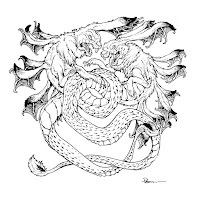 I printed out the above design at full scale and taped that onto the back of a sheet of Strathmore 300 series bristol. Using a lightpad, I was able to see through the surface of the bristol as I inked the dragon. I used Copic Multiliner 0.7 pen to ink the art.
I printed out the above design at full scale and taped that onto the back of a sheet of Strathmore 300 series bristol. Using a lightpad, I was able to see through the surface of the bristol as I inked the dragon. I used Copic Multiliner 0.7 pen to ink the art.The inking on this piece was mostly just about respecting the contour lines from the pencils and enhancing them with line-weight, while also not overworking anything to make it muddy. I finished the inks on-stream, but then afterwards decided I wanted to add a little texture inside the bat wings, so I inked those in before scanning it.
 Later that same night after some dinner I started the coloring process. After prepping the digital scan of the inks, I established a color hold (an area where I want the ink to be a color other than black)––the overall lines became a dark brown and then a smaller hold on the pupils.
Later that same night after some dinner I started the coloring process. After prepping the digital scan of the inks, I established a color hold (an area where I want the ink to be a color other than black)––the overall lines became a dark brown and then a smaller hold on the pupils.Then it was time to start the color flatting process––basically professional coloring-in-the-lines. Some of this is just to make it easy to re-isolate various parts when doing later painting & rendering. Some of of the colors were established in the rough, but I played with the final value/hue choices for a while before getting to this point.
For the final colors I used the dodge and burn tools to add shadows and highlights to give the dragons some form. Most of the work was getting the shadows where the interwoven knotting is happening.
Below you can again see the final Dragon...

But, as this is a community event, I wanted to share all the other entries posted in the Discord.
 Capt Nemo
Capt Nemo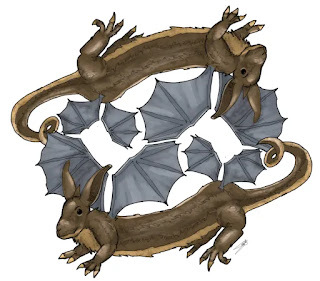 Jonathan Towry
Jonathan Towry 88UncleErnie
88UncleErnie Nathan Pride
Nathan Pride Nuvalo
Nuvalo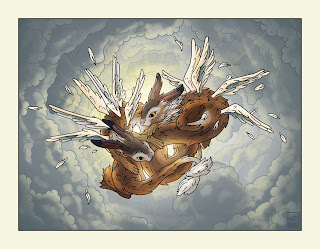 redSkwrl
redSkwrl ShadowindART
ShadowindART VernNYC
VernNYCJuly 2, 2024
Hellboy 30th Anniversary
 For Hellboy's 30th Anniversary, I was asked to contribute a piece of artwork for a gallery exhibition at the Copro Gallery in Sherman Oaks, CA to celebrate three decades of Mike Mignola's creation. I've been a fan of Hellboy since the 2nd issue (my local store at the time somehow didn't get enough copies of #1 and I had to hunt it down later) and I've credited Mike's time with Hellboy as a roadmap for my goals for a comics career.
For Hellboy's 30th Anniversary, I was asked to contribute a piece of artwork for a gallery exhibition at the Copro Gallery in Sherman Oaks, CA to celebrate three decades of Mike Mignola's creation. I've been a fan of Hellboy since the 2nd issue (my local store at the time somehow didn't get enough copies of #1 and I had to hunt it down later) and I've credited Mike's time with Hellboy as a roadmap for my goals for a comics career.A decade ago I did a 20th anniversary piece: http://davidpetersen.blogspot.com/2014/03/hellboys-20th-anniversary.html. To the left you can see my final colored (just for fun) piece, and below I walk through the steps to creating it as well as showing the inks that will be in the gallery exhibition (and for sale)
 The process started with lots of ruminating over what do do with Hellboy. I've never drawn him for a cover, but between the 20th anniversary piece and the Kickstarter print for the Drawing Monsters Kickstarter I didn't want to repeat myself. I opted for an action pose (this is after discarding a very static sketch of Hellboy with animals from Mouse Guard while holding the Black Axe). I kept the Black Axe in this rough, but I drew and redrew a few variations of his surroundings with iterations of bone-dragon/snakes he was smashing apart before wanting to include a belltower I saw on my trip to Lake Como in May. The crumbling belltower drawing and Hellboy drawing were put together in Photoshop along with some blocked in color and a special clock-face with the hands at 30.
The process started with lots of ruminating over what do do with Hellboy. I've never drawn him for a cover, but between the 20th anniversary piece and the Kickstarter print for the Drawing Monsters Kickstarter I didn't want to repeat myself. I opted for an action pose (this is after discarding a very static sketch of Hellboy with animals from Mouse Guard while holding the Black Axe). I kept the Black Axe in this rough, but I drew and redrew a few variations of his surroundings with iterations of bone-dragon/snakes he was smashing apart before wanting to include a belltower I saw on my trip to Lake Como in May. The crumbling belltower drawing and Hellboy drawing were put together in Photoshop along with some blocked in color and a special clock-face with the hands at 30. The above layout was printed and taped to the back of a sheet of Strathmore 14" x 17" sheet of bristol. On my Huion lightpad I was able to see through the bristol to use the layout as a guide to ink from. I used Copic Multiliner SP pens to ink with.
The above layout was printed and taped to the back of a sheet of Strathmore 14" x 17" sheet of bristol. On my Huion lightpad I was able to see through the bristol to use the layout as a guide to ink from. I used Copic Multiliner SP pens to ink with. Since the original inked artwork was the piece to be displayed in the gallery show, I focused on making it read clearly without color. That meant adding a lot of tone and texture to all the crumbling bits of tower stones, while leaving Hellboy rather clean line-wise. The framed original will be available for sale through the Copro Gallery.
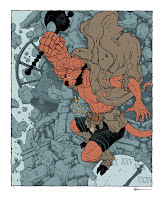
Just for fun, I wanted to color the inks after I scanned them. It figured it would be good to see the piece in color again (the purpose of the layout's color blocking was to help me see forms as I inked; what was coat or right hand of doom, or stone or beam, or bell, or sky).
This first step of coloring is called 'flatting' and is basically a professional version of coloring-in-the-lines with flat colors to establish each area's base color. At this step I also added color holds (areas where I want the inkwork to be a color other than black) to the entire background as well as the numbers on the clock and the 'US' patch on Hellboy's holster.
Below you can see the finsihed just-for-fun colors (I never make prints of characters I don't have the right for). I did a lot more painting on this piece than my normal coloring process. Rather than using Doidge and burn tools for the majority of the rendering, I painted in shadows with the same color as the dark blue lines of the background, and added in highlights with a lighter warmer color.

June 25, 2024
Recent Commissions

A Scouting Mouse
 A Fan's RPG Mouse Archer Character
A Fan's RPG Mouse Archer Character Guardmouse with sword & torch
Guardmouse with sword & torch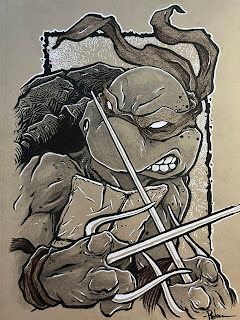 Raphael, a TMNT
Raphael, a TMNT
Usagi Yojimbo
 Guardmouse with a spear
Guardmouse with a spear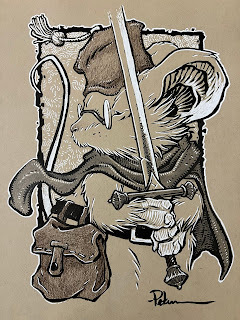
Traveling Adventurer Guardmouse

Kenzie
 Saxon
Saxon Lone Wolf & Cub
Lone Wolf & Cub Beep the Meep
Beep the Meep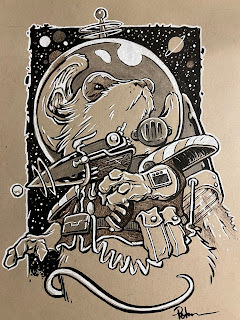 Sci-Fi Mouse
Sci-Fi Mouse
TMNT in Samurai Armor on a Sketch Cover
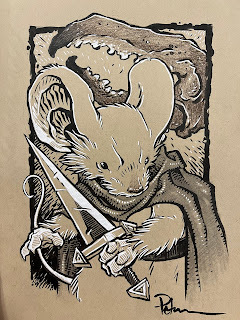 Lieam with a crab looming
Lieam with a crab looming Weasel wearing House of Slaughter Mask
Weasel wearing House of Slaughter Mask from Something is Killing the Children
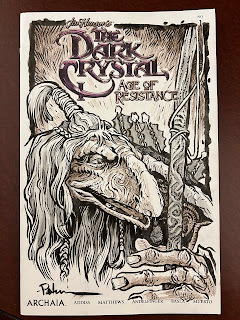 urVa the Archer on a sketch cover
urVa the Archer on a sketch cover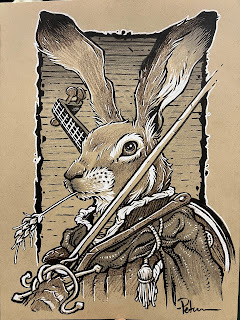 A fan's Harengon D&D character
A fan's Harengon D&D character
June 18, 2024
Guardmouse in Hawk Nest
 Before leaving for Lake Como Comic Art Festival I finished a few inked pieces that would be Mouse Guard inked original Artwork available for sale.
Before leaving for Lake Como Comic Art Festival I finished a few inked pieces that would be Mouse Guard inked original Artwork available for sale. My idea was that these would also serve as pages for the next Mouse Guard sketchbook tentatively titled: 'Past Whereabouts'.
To the left you can see the finished colored piece for the sketchbook, but below I'll walk through the process of creating the artwork.
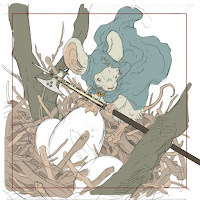 This piece started with the mouse drawing, a Guardmouse holding on to the edge of something, a high rock face, a tree trunk, or––as I ultimately drew in, a hawk's nest.
This piece started with the mouse drawing, a Guardmouse holding on to the edge of something, a high rock face, a tree trunk, or––as I ultimately drew in, a hawk's nest.As I drew the mouse, I liked the plan that this was a younger patrolling Gwendolyn before her time as a Matrirch (though I forgot to add her normal skirting which would help identify her, but also makes sense not to wear when climbing harrowing heights.)
The pencil sketch was scanned into Photoshop so I could block in some color to help me see what areas where what textures. I also added in a photo of a halberd blade for reference.
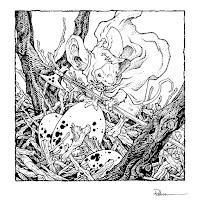 The above layout was printed out and taped to the back of a Strathmore 300 series sheet of smooth bristol. On my Huion Lightpad I can see through the surface of the bristol and use the printout as a guide to ink from.
The above layout was printed out and taped to the back of a Strathmore 300 series sheet of smooth bristol. On my Huion Lightpad I can see through the surface of the bristol and use the printout as a guide to ink from.I used Copic Multiliner SP pens to do the linework, most of which was focused on giving the nest and branches texture and depth while leaving Gwendolyn relatively clean so she could be seen.
The original inks for this piece are available for sale in my online store:
https://mouseguard.bigcartel.com/product/guardmouse-in-hawk-s-nest
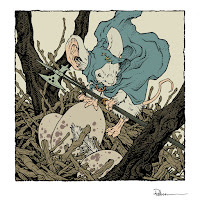 After the inks were finished, I scanned them into Photoshop and started the coloring process. This first step is called 'flatting' because it's just about adding flat colors to all the various areas (her fur color, her cloak color, the sky, the branches, the nest, etc.) It's a professional version of coloring-in-the-lines.
After the inks were finished, I scanned them into Photoshop and started the coloring process. This first step is called 'flatting' because it's just about adding flat colors to all the various areas (her fur color, her cloak color, the sky, the branches, the nest, etc.) It's a professional version of coloring-in-the-lines. At this stage I also added a color hold (areas where I want the inkwork to be a color other than black) to the spots on the eggs. I also end up adding another one to act as a light corona in the final coloring stage)
 The final color rendering was done using Photoshop's Dodge and Burn tools (to lighten and darken whatever color is present) and a stock textured brush. I did use the paint brush a bit to make my own blush gradient in the background, and I selected areas with the lasso tool and shifted color balance to give nest twigs different tones and Gwendolyn's nose bit of pink.
The final color rendering was done using Photoshop's Dodge and Burn tools (to lighten and darken whatever color is present) and a stock textured brush. I did use the paint brush a bit to make my own blush gradient in the background, and I selected areas with the lasso tool and shifted color balance to give nest twigs different tones and Gwendolyn's nose bit of pink.As I said at the start, this will eventually be published in my next sketchbook which may be out at the end of this year or the start of next (depending on timing with getting enough pages done between projects AND convention schedules)
David Petersen's Blog
- David Petersen's profile
- 339 followers



